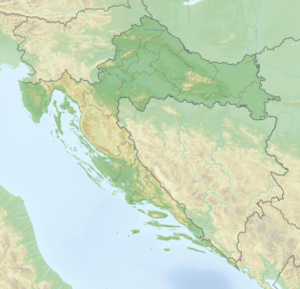Mljet
| Mljet | ||
|---|---|---|
| NASA satellite image, Mljet Island center right | ||
| Waters | the Adrian Sea | |
| Geographical location | 42 ° 45 ' N , 17 ° 32' E | |
|
|
||
| length | 37 km | |
| width | 3.2 km | |
| surface | 98.01 km² | |
| Highest elevation | Veliki grad 514 m |
|
| Residents | 1088 (2011) 11 inhabitants / km² |
|
| main place | Babino Polje | |
| Situation map | ||
The island of Mljet [ ˈmʎɛt ] (Italian Meleda , Latin Melitussa ), also called " Odysseus Island", is located in the Croatian Adriatic Sea , about 30 km northwest of Dubrovnik .
geography
Mljet is around 37 km long and up to 3.2 km wide, the area is 98.01 km² . With a forest share of 90 percent, it is one of the most heavily forested islands in the Mediterranean .
The western part of the island is formed by the Mljet National Park , which also includes the surrounding marine area. Politically, the island of Mljet today forms a municipality within the Dubrovnik-Neretva County with 1,088 inhabitants (as of 2011) in numerous settlements, most of which are inland. The main town is the settlement Babino Polje in the center of the island.
history
In ancient times, the island inhabited by Illyrians was considered a notorious pirate's nest. For this reason Augustus attacked Mljet, had part of the population led into slavery or to the rowing benches, killed the rest of the population and from then on used the island as a place of exile.
Mljet is next to Malta and (according to a more recent theory, which can also be based on a local tradition) Kefalonia one of the islands that claims to be the island of Melite, where according to Acts 27: 27 ff. EU the Apostle Paul Shipwrecked. This is first mentioned in the document De Administrando Imperio by the Byzantine emperor Constantine VII Porphyrogenetus . This thesis is supported by the reference in Acts 28,2 + 4 EU that the inhabitants were “ barbarians ” (i.e. non-Greeks and non-Romans), but the further course of the apostle's journey with a ship from Alexandria that wintered on the island in question and then first drove to Syracuse and from there to Rome , seen as a geographical argument against this thesis.
From the 6th century Mljet belonged to the Byzantine Empire. The island was incorporated into the newly formed Dalmatia theme in the 8th century . Emperor Constantine VII Porphyrogenetus mentioned Mljet around 950 in his already mentioned De Administrando Imperio as one of the islands ruled by the Slavic Narentans .
In 1151 the island came into the possession of the Benedictines from Pulsano on Monte Gargano in Apulia , who in turn recognized the suzerainty of the Serbian Nemanjids . The Benedictines founded the monastery of St. Mary, the church was donated by Stefan Nemanjić . In 1357 the Serbian Emperor Stefan Uroš V transferred sovereignty over the island to his follower Balša I. A little later, a free commune with its own statutes was formed on the island.
In 1410 the Republic of Ragusa annexed Mljet. The islanders had to pay a tribute to the government of the republic. The Benedictine monastery also flourished under the ragusan rule. It was the leading abbey of the Congregatio Melitensem named after him , which included all Benedictine monasteries on the territory of the Republic of Ragusa. Abbot Mavro Vetranović was a well-known poet of the 16th century. In the 18th century the seat of the Congregation was moved from Mljet to St. Jacob near Dubrovnik and the island monastery lost its importance. It was dissolved in 1809 under Napoleonic rule. During the Austrian period it was the seat of the forest administration and after the First World War it came into the possession of the Dubrovnik diocese. Expropriated after 1945, the monastery was converted into a hotel in the 1950s, when the order had long since given up the abbey, and was used in this form from 1960 until it was returned to the diocese in 1998. A revival of the monastery by Benedictines has recently been sought. In 2010, Austrian icon painters (Magdalena, Martina and Peter Eichhorn from Innsbruck) created an icon of Saint Benedict. Today it hangs on the pillar to the left of the altar.
A large part of the island was declared a nature reserve as early as 1910 and a national park was established in 1958.
gallery
Port of Pomena
See also
literature
- Ivo Dabelić: Mljet: Zeleni otok. Zgodovina, kultura, umetnost, naravne lepote, turizem, nacrt otoka Mljet. Zagreb 2004. ISBN 953-215-171-0 ( tourist guide )
- Antun Tonko Vojvoda: Mljet - Odisejev otok. Zagreb 1999. ISBN 953-97949-0-0 ( history )
- Branko Kesić (Ed.): Otok Mljet. Ekološke i zdravstvene prilike. Zagreb 1989. ( ecology )
- Branimir Gušić: Otok Mljet. Naš novi nacionalni park. Antropogeografski pregled i kulturno histor. spomenici. Zagreb 1958. ( ecology )
- Milan Senoa: The island of Mljet (Meleda). Vienna & Leipzig [1915]. ( Story )







